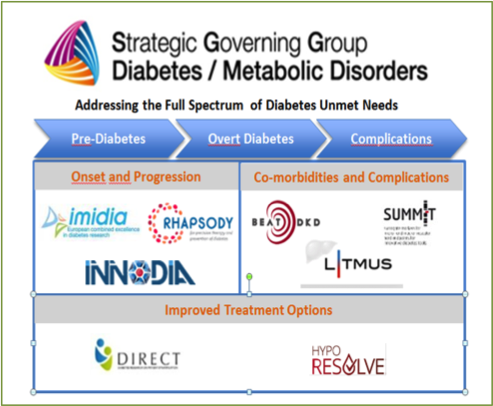Collaboration: The key to diabetes (Guest blog)
Today more than 400 million diabetic patients are estimated worldwide and the number is expected to even rise to 552 million by 2030. Diabetes with its associated complications is a severe and pandemic disease causing human suffering but also represents a major burden both for society and healthcare systems and hence one of the biggest social economic challenges of our time.
The Innovative Medicines Initiative (IMI) is the largest public private partnership in life science globally, enabling a unique collaboration of pharmaceutical companies, leading clinical and academic institutions, regulatory and market access bodies as well as patient organizations. The overall budget of 5.2 Billion € is jointly provided by EFPIA companies as in-kind and by the European Commission as cash funding to academic and public participants.
Within the IMI Strategic Governing Group Diabetes/Metabolic disorders 16 EFPIA companies have joined forces to develop unique innovative projects addressing bottlenecks in order to deliver better health care solutions for diabetes. As of today 250 Million € are allocated to this task.
The first IMI projects have recently been completed and delivered impressive results. An outstanding example is the IMIDIA project dealing with the insulin producing beta-cell function. It has successfully developed the first disease relevant human beta-cell line as well as disease specific in-vivo models strongly improving research and development in type-2 diabetes.
Ongoing IMI projects like DIRECT and RHAPSODY address the heterogeneity of type-2 diabetes and aim to identify biomarkers for a better classification of patients for existing or novel therapies and thus deliver more individualized therapies.
Other ongoing IMI 2 projects are addressing severe complications in the later stage of type 2 diabetes. BeatDKD aims at diabetic kidney disease, a severely and progressively debilitating condition, the LITMUS project addresses fatty liver disease commonly accompanying obese diabetics (not related to alcohol abuse), being a starting point to irreversible tissue destruction (fibrosis and cancer). The objective of those projects are to better understand the mechanisms and development of these complication by identifying easy accessible indicators (e.g. in blood) that would facilitate diagnosis and enable prediction of disease progression and in turn improved therapy.
A new IMI 2 project strives to elucidate the underlying mechanisms of hypoglycemia, which hinders optimal insulin therapy in patients with insulin-dependent diabetes. In parallel, another new diabetic cardiomyopathy IMI 2 project investigates what makes diabetics 4-fold more susceptible to this heart failure condition through in-depth analysis and comparison of medical profiles of heart failure patients with and without diabetes.
Another focus is on type 1 diabetes, presenting most typically in children and adolescents. It lacks scientific understanding of the triggering events and disease progression. Within the INNODIA consortium the scientists are aiming to understand and differentiate the multifaceted mechanisms. They will create novel tools for diagnosis, models to improve researching the disease mechanisms and a clinical network allowing accelerated, specialized and standardized clinical studies.
Indeed, we must acknowledge that no single institution, company, university, country, or government has a monopoly on innovation or could succeed in deciphering the complexity of human diseases.
I was impressed to see the yield of already available tangible, and intangible achievements, enabled by strict governance along agreed demanding objectives, paving the way to novel, safe and cost-effective solutions empowering life.
